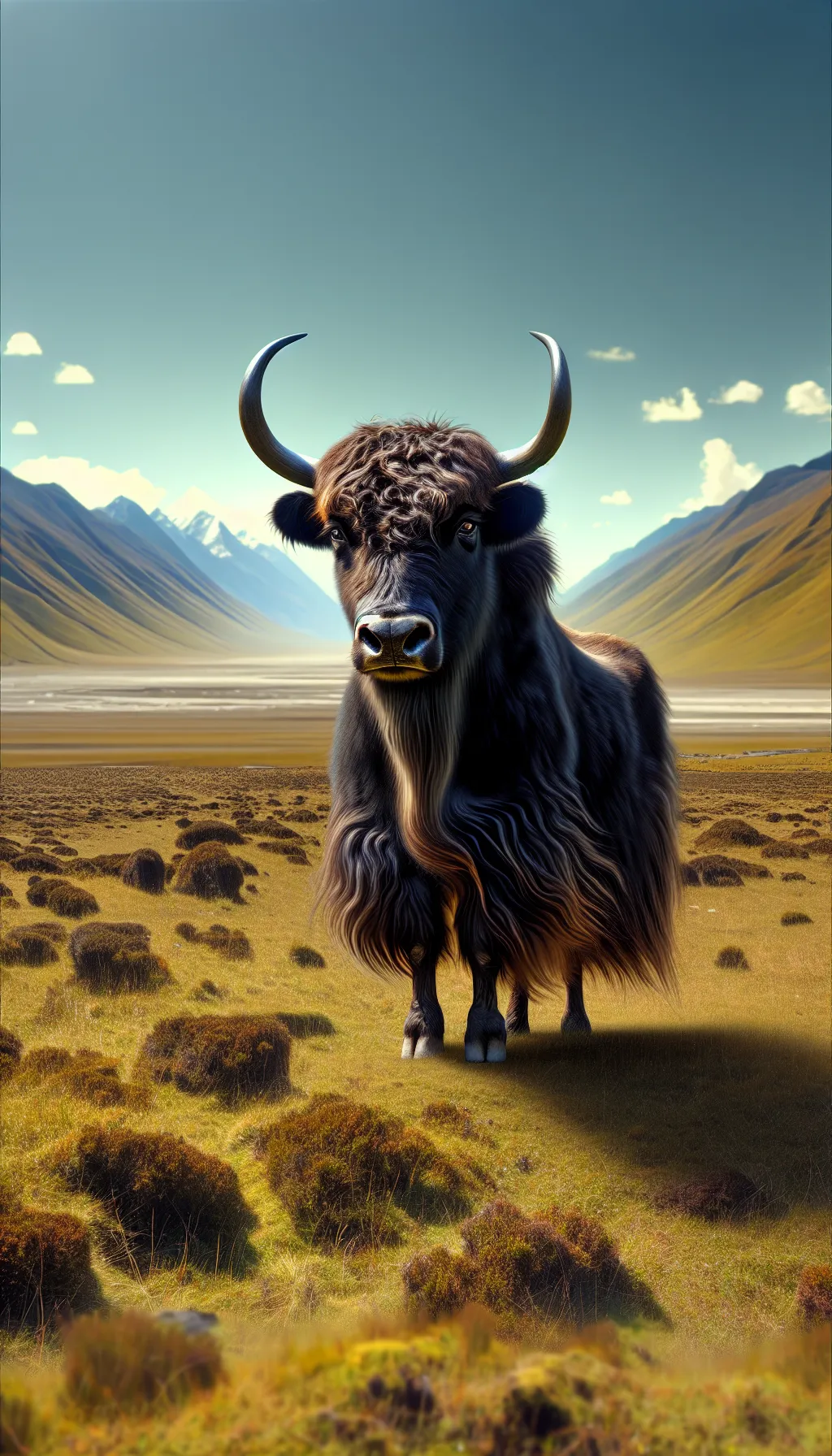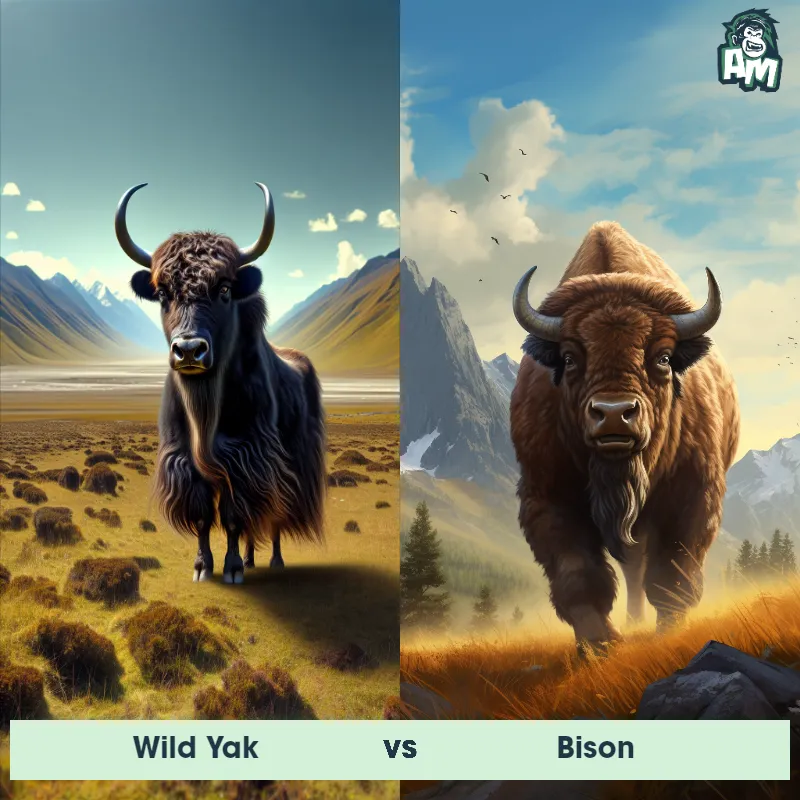The Wild Yak
The Wild Yak, also known as the Bos mutus, is a large bovine species native to the Tibetan Plateau and the surrounding regions in Central Asia. They are known for their impressive size, with males standing up to 6 feet tall at the shoulder and weighing over a ton. The Wild Yak has a robust build, with a massive head, curved horns, and a dense long coat that protects them from the extreme cold temperatures in their habitat. Their fur ranges from dark brown to black, with a lighter-colored muzzle and sometimes a distinctive fringe of hair on their throat. They are well-adapted to mountainous terrains, often seen grazing on alpine meadows and slopes between 13,000 and 18,000 feet. Wild Yaks are highly social animals and live in herds of up to 30 individuals, led by a dominant male known as the "bull yak."

| Wild Yak | |
|---|---|
| Size | 5-7 feet (1.5-2.1 meters) tall at the shoulder |
| Weight | Up to 2,000 pounds (907 kilograms) |
| Speed | 20mph (32.2km/h) |
| Key Strength | Powerful horns and robust build |
| Biggest Weakness | Lack of speed and agility |
| Scientific Name | Bos mutus |
| Family | Bovidae |
| Habitat | Alpine meadows and grasslands |
| Geography | Tibetan Plateau and surrounding regions |
| Diet | Grazes on grasses, herbs, and lichens |
| Lifespan | 8 years - 12 years |

The Wild Yak
The Wild Yak, also known as the Bos mutus, is a large bovine species native to the Tibetan Plateau and the surrounding regions in Central Asia. They are known for their impressive size, with males standing up to 6 feet tall at the shoulder and weighing over a ton. The Wild Yak has a robust build, with a massive head, curved horns, and a dense long coat that protects them from the extreme cold temperatures in their habitat. Their fur ranges from dark brown to black, with a lighter-colored muzzle and sometimes a distinctive fringe of hair on their throat. They are well-adapted to mountainous terrains, often seen grazing on alpine meadows and slopes between 13,000 and 18,000 feet. Wild Yaks are highly social animals and live in herds of up to 30 individuals, led by a dominant male known as the "bull yak."
Fun Fact: The Wild Yak is considered one of the largest and most formidable wild cattle species in the world, capable of charging at speeds of up to 20 mph when threatened or during mating season.
| Wild Yak | |
|---|---|
| Size | 5-7 feet (1.5-2.1 meters) tall at the shoulder |
| Weight | Up to 2,000 pounds (907 kilograms) |
| Speed | 20mph (32.2km/h) |
| Key Strength | Powerful horns and robust build |
| Biggest Weakness | Lack of speed and agility |
| Scientific Name | Bos mutus |
| Family | Bovidae |
| Habitat | Alpine meadows and grasslands |
| Geography | Tibetan Plateau and surrounding regions |
| Diet | Grazes on grasses, herbs, and lichens |
| Lifespan | 8 years - 12 years |
Wild Yak Matchups
We use AI to simulate matchups between the Wild Yak and other animals. Our simulation considers size, strength, and natural predatory behaviors to determine the most likely outcome.

Can't find the Matchup you want?
Create Your Own MatchupWild Yak: Diet, Predators, Aggression, and Defensive Behaviors
What do Wild Yaks eat?
Wild Yaks are herbivores and primarily graze on grasses, lichens, and other vegetation found on the high-altitude plateaus and mountains where they live. They have specialized digestive systems that allow them to extract nutrients from the tough, fibrous plants that grow in their harsh habitat.
Do Wild Yaks have any predators?
Wild Yaks do not have many natural predators due to their large size and powerful build. However, they may sometimes be targeted by wolves, snow leopards, and bears. These predators usually target weaker or sick individuals, as healthy adult yaks are quite formidable and can defend themselves effectively.
Are Wild Yaks aggressive?
Wild Yaks are known for their aggressive behavior, especially during mating season or when defending their territory. They are known to charge at perceived threats, including humans, and can be dangerous if provoked. It is recommended to keep a safe distance when encountering wild yaks in their natural habitat.
Do Wild Yaks fight each other?
During mating season, male Wild Yaks may engage in fights with each other to establish dominance and gain access to females. These fights can be intense, with the yaks using their horns and powerful bodies to push and shove each other. The dominant male will then have mating rights with the females in the herd.
How do Wild Yaks defend themselves?
Wild Yaks have several defenses to protect themselves from predators and threats. Their large size, powerful horns, and strong hooves make them formidable opponents. When threatened, they may charge, stampede, or form a defensive circle with the youngest and weakest individuals in the center, facing outward to fend off attackers.
What is the Wild Yak's biggest weakness in a fight?
Despite their size and strength, Wild Yaks can be vulnerable to attacks from predators due to their relatively slow speed and lack of agility. They are most at risk when isolated from the herd or when faced with multiple attackers, as they are best equipped to defend themselves when in a group. Additionally, young or injured yaks may also be more susceptible to predators.
Fun Fact: Wild Yaks have an incredible ability to survive in high-altitude environments, with adaptations such as an enlarged heart and lungs, as well as a unique form of hemoglobin in their blood that allows them to extract oxygen more efficiently from thin mountain air.
Fun Fact: The Wild Yak has a distinctive smell that is described as musky or pungent, which is believed to serve as a means of communication between individuals and also helps them establish and maintain their social hierarchies within the herd.













